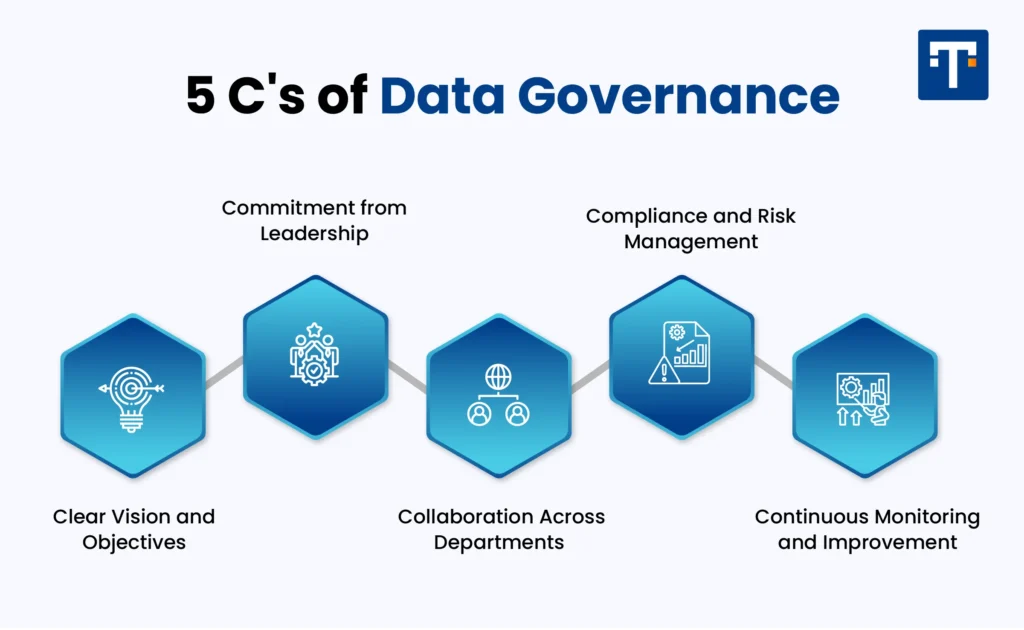Necessary Always Active
Necessary cookies are required to enable the basic features of this site, such as providing secure log-in or adjusting your consent preferences. These cookies do not store any personally identifiable data.
|
||||||
|
||||||
|
||||||
|

Data governance is very important for every organization. In today’s world, data lies at the heart of operations, driving efficiency and decision-making. Just as hospitals rely on data to diagnose illnesses, track patient progress and conduct research, data governance helps to oversee these records to avoid inconsistent data.
To achieve data governance, it is important to define your goals up front. Why are you governing data? Is it for compliance, security, accuracy, better decision making or improved data quality?
Then there is a data governance program which must be managed by a governance team, a steering committee that acts as the governing body, and a group of data stewards. Digital transformation in industrial sectors has led to the rise of data governance software and tools, which provide essential capabilities for effectively managing such programs.
This article on data governance covers why it matters and how it ensures accuracy, security and compliance of data in enterprise systems.
As organizations rely on data for decision-making, customer interactions, and business strategy, it is important to prevent data inconsistencies to ensure smooth data integration.
Without effective data governance, customer records can sometimes be listed differently in sales, customer service and logistics. Hence, data governance matters more than ever now because it will help correct data integrity issues that could hinder the operation and accuracy of business intelligence.
However, with the increasing volume and complexity of data, challenges such as data silos, inconsistent data quality, and evolving regulatory requirements have emerged.
Effective data governance addresses these challenges by establishing clear policies and procedures for data management. It ensures that data is accurate, accessible, and protected, thereby enabling organizations to harness the full potential of their data assets.
In essence, data governance acts as the backbone for organizations to manage, protect, and harness the true value of their data. It is not optional but a crucial element of modern data management. A strong governance framework will position companies for growth, innovation, and sustainability in a data-driven world.
Data governance is a structured way for organizations to manage and control their data assets. Its rules, processes and tools ensure that data is used effectively to achieve business goals.
For most organizations, data governance is very essential as they need to rely on data for decisions, daily operations and customer interactions.
A study by IDC found that organizations lose up to 12% of their revenue due to poor data quality within their business processes.
While there is a misconception that data governance helps organizations to manage risk, it is also about unlocking the value of data.
Hence, data governance deals with managing data with a focused approach, establishing policies, procedures, and standards to ensure data accuracy, accessibility, consistency, and security.
The four fundamental pillars that support a robust data governance framework are:
1. Data Quality: Ensuring the accuracy, completeness, and reliability of data. High-quality data is essential for making informed decisions and achieving operational excellence.
2. Data Stewardship: Assigning responsibility for data management to designated individuals or teams. Stewards ensure that data policies are followed and that data assets are used appropriately.
3. Data Protection and Compliance: Implementing measures to safeguard data and ensure adherence to relevant regulations. This includes protecting sensitive information from breaches and ensuring compliance with laws such as GDPR and HIPAA.
4. Data Management: Establishing processes and policies for effective data handling throughout its lifecycle. This includes data storage, archiving, and disposal practices that align with organizational standards.
These pillars provide a solid foundation for establishing a robust data governance framework. By focusing on these areas, organizations can create a cohesive strategy that enhances data integrity and usability.

The 5 C’s provide a structured approach to managing data effectively:
1. Clear Vision and Objectives: Defining specific goals for data governance aligned with business strategies. A clear vision ensures that all stakeholders understand the purpose and direction of data governance initiatives.
2. Commitment from Leadership: Securing executive support to ensure adequate resources and enforcement of policies. Leadership commitment is crucial for overcoming resistance to change and for the successful implementation of governance frameworks.
3. Collaboration Across Departments: Encouraging cross-functional teamwork to align governance efforts organization-wide. Collaboration fosters a unified approach to data management, breaking down silos and promoting consistency.
4. Compliance and Risk Management: Conducting regular audits and assessments to ensure adherence to regulations and mitigate risks. Proactive risk management helps in identifying potential issues before they escalate into significant problems.
5. Continuous Monitoring and Improvement: Regularly evaluating governance practices to identify areas for enhancement. Continuous improvement ensures that data governance remains effective and relevant in a changing business environment.
Understanding these components is crucial for any organization aiming to harness the power of data-driven decision-making. Implementing the 5 C’s can lead to more effective governance practices that support organizational objectives.
Accurate data is the cornerstone of reliable analytics and informed decision-making. To maintain data accuracy:
Data Quality Standards: Define criteria for data validity, completeness, and consistency. Regularly review and update these standards to adapt to evolving business needs.
Validation and Cleansing: Implement processes to detect and correct errors, such as data profiling and cleansing techniques. Routine audits can help identify and rectify inaccuracies promptly.
By prioritizing data accuracy, organizations can trust their data assets to drive strategic initiatives effectively.
Protecting sensitive data is paramount in today’s threat landscape. Effective data governance incorporates several security measures:
Implementing these measures helps safeguard data against breaches and unauthorized access, maintaining stakeholder trust.
Navigating the complex landscape of data regulations requires a proactive approach:
By embedding compliance into the data governance framework, organizations can mitigate legal risks and avoid costly penalties.
For an effective data governance program, it is important to:
By following these best practices, organizations can build a robust data governance program that supports accuracy, security, and compliance.
In conclusion, data governance is not merely a regulatory requirement but a strategic asset that enhances data quality, protects against security threats, and ensures compliance. By implementing a comprehensive data governance framework, organizations can unlock the full potential of their data assets, driving informed decision-making and sustainable growth.
Sign up to receive our newsletter featuring the latest tech trends, in-depth articles, and exclusive insights. Stay ahead of the curve!